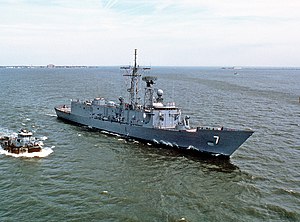 USS Oliver Hazard Perry underway during a Great Lakes cruise, 24 August 1979.
| |
| History | |
|---|---|
| Name | Oliver Hazard Perry |
| Namesake | Oliver Hazard Perry |
| Ordered | 10 March 1973 |
| Builder | Bath Iron Works |
| Laid down | 12 June 1975 |
| Launched | 25 September 1976 |
| Commissioned | 17 December 1977 |
| Decommissioned | 20 February 1997 |
| Stricken | 3 May 1999 |
| Homeport | Mayport (former) |
| Identification |
|
| Motto | "Don't Give Up the Ship" |
| Nickname(s) |
|
| Honors and awards | See Awards |
| Fate | Scrapped, 9 September 2005 |
| Badge |  |
| General characteristics | |
| Class and type | Oliver Hazard Perry-class frigate |
| Displacement | 4,100 long tons (4,200 t), full load |
| Length | 445 feet (136 m), overall |
| Beam | 45 feet (14 m) |
| Draught | 22 feet (6.7 m) |
| Propulsion |
|
| Speed | over 29 knots (54 km/h) |
| Range | 5,000 nautical miles at 18 knots (9,300 km at 33 km/h) |
| Complement | 15 officers and 190 enlisted, plus SH-2 detachment of roughly six officer pilots and 15 enlisted maintainers |
| Sensors and processing systems |
|
| Electronic warfare & decoys | AN/SLQ-32 |
| Armament |
|
| Aircraft carried | 1; SH-2 Seasprite helicopter (ship was to have capability for two helicopters, but never carried more than one due to flight deck and hangar size limitations) |
| Aviation facilities | Hangar Bay, Helicopter Pad |
USS Oliver Hazard Perry (FFG-7) was the lead ship of the Oliver Hazard Perry class of guided-missile frigates. She was named for Oliver Hazard Perry, an American naval hero who was victorious at the 1813 Battle of Lake Erie. Oliver Hazard Perry (FFG-7) was the first ship and, as of 2019, the only ship of the U.S. Navy to bear the name (although there were five previous US Navy ships named for Oliver Hazard Perry – four named USS Perry and one named USS Commodore Perry). Oliver Hazard Perry was in service from 1977 to 1997 and was scrapped in 2005.
The class was originally intended as austere "low" category guided missile frigates (compared with the high capability Spruance class) for General Purpose and Anti-Air convoy escort. They were built under a cloud of controversy, with their very light gun armament and lack of redundancy and duplicated systems in event of ship being hit. They were regarded by the Reagan administration and Secretary John Lehman as not part of the 500 ship navy plan, but ultimately proved useful as anti-submarine ships if fitted to carry Seahawks and towed arrays and into the 21st Century as low grade patrol ships making up the numbers in a USN desperately short of escorts.